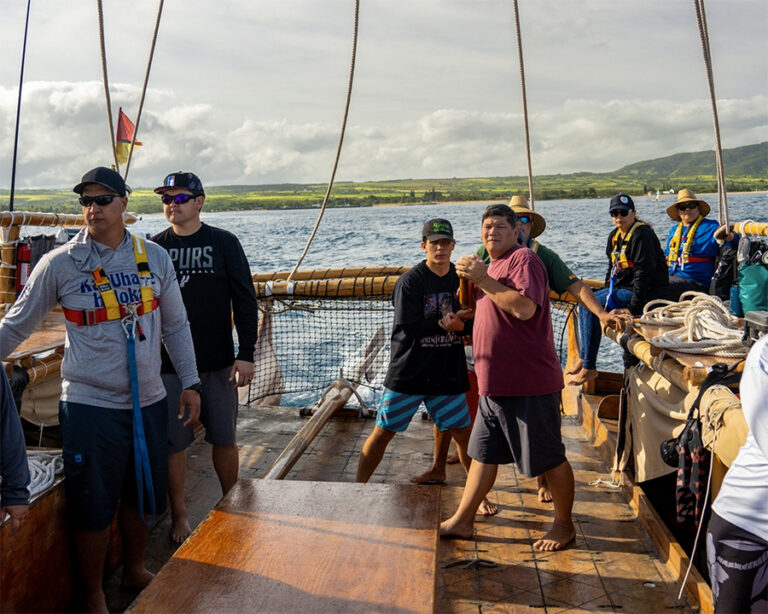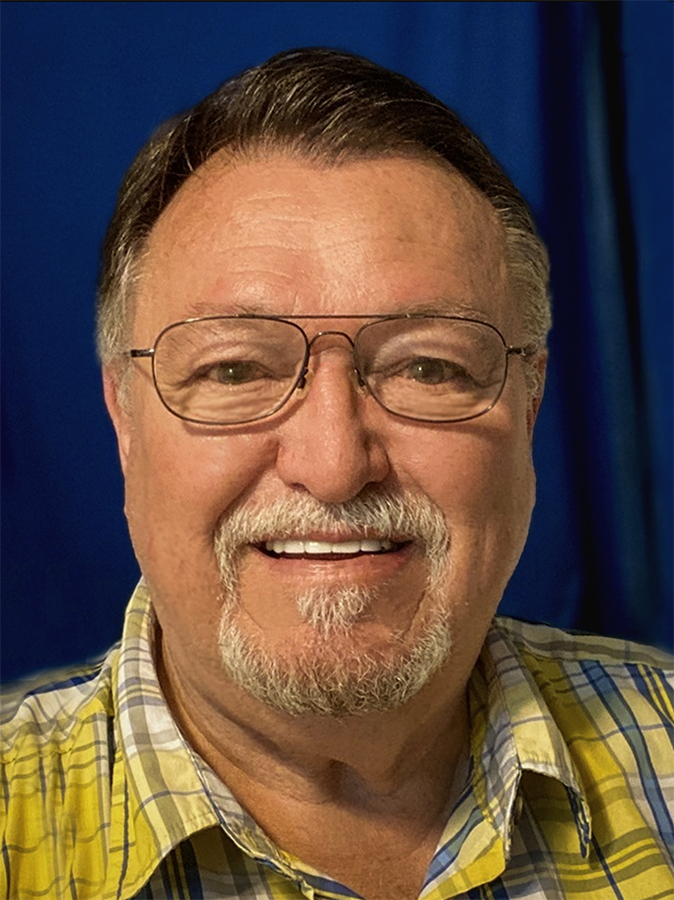MARK ELLIS CAPTIONS THE IOSEPA IN 2024 ON ITS FIRST VOYAGE IN THE PAST EIGHT YEARS
By Mike Foley

The Polynesian Cultural Center hired 1994 BYU–Hawaii organizational behavior alumnus Mark Ellis in early 2024 to fill the new position as director of voyaging experiences, and that summer he spent 29 days captaining BYUH’s 57-foot iconic wa’a kaulua or double-hulled sailing canoe, the Iosepa, on its first open-ocean journey in the past eight years.
Starting the voyage, Ellis led the Iosepa to a historic gathering of 26 other traditional Pacific Island vessels at Kualoa Beach on June 4, 2024, as part of the Festival of Pacific Arts and Culture’s first gathering in Hawaii. After the event, Ellis and crew circumnavigated O’ahu before returning to Laie.
FestPAC and a Pacific sailing canoe renaissance — FestPAC started a series of rotating venue, quadrennial two-week cultural celebrations of indigenous island peoples and nations from throughout the Pacific Ocean in 1972.
The beginning of the renaissance in traditional Pacific voyaging canoes is often attributed to the Honolulu-based Polynesian Voyaging Society, which was founded in 1973. PVS soon after began to build its famous twin-masted canoe, Hōkūle‘a, and in a well-documented trip in 1976, the Hōkūle‘a crew sailed round-trip to Tahiti using only non-instrument wayfinding.
To accomplish that feat, PVS crewmembers relied heavily on training from the late Pius “Papa Mau” Piailug — a master navigator from the remote coral atoll of Satawal in the Eastern Caroline Islands of Micronesia where a small number of people had kept alive the traditions of open-ocean canoes using the old ways.
Ellis remembers becoming intrigued at that time when he first saw the Hōkūle‘a as a Hawaiian boy in Honolulu; and he credits his parents, Mike and Leah Ellis — both CCH/BYUH alumni — for encouraging him after he graduated from Roosevelt High to participate in “Bridges,” a pilot program to help local students transition to BYU–Hawaii.
BYU–Hawaii launched the Iosepa in 2001: Ellis had already served a mission in Las Vegas, graduated from BYUH, and moved on to Utah State University where he earned a master’s degree in instructional technology. He had already begun a career in that field when BYUH started its own Hawaiian Studies program in 1998.
Not surprisingly, initial Hawaiian Studies faculty and students dreamed of creating their own sailing canoe from the beginning, and with administrative support, special grants, and donations, this became a reality in 2001.
Early that year, the late William “Uncle Bill” Kaua‘iwiulaokalani Wallace III, the first BYUH Hawaiian Studies director, received approval to commission master carver Tui’one Pulotu and Hawaiian master carver Kawika Eskaran — both of them BYUH and Cultural Center alumni — to take on the as-yet-unnamed canoe project.
An astounding 105-foot canoe: Pulotu, a former labor missionary from Tonga, settled in Laie after helping expand the BYUH campus, erect other Church-related facilities on Oahu, and build the Polynesian Cultural Center in the early 1960s. Though largely self-taught, Pulotu went on to create many astounding carvings and cultural projects, more recently including the Mileniume — a 105-foot double-hulled wooden canoe in Tonga that marked the 2000 millennium.
Eskaran, whose interest in carving began from boyhood, was already known for his own fine-detail carvings at the PCC, came aboard as soon as he could make the transition.
While the Hōkūle‘a and other early renaissance canoes were mostly created out of fiberglass, BYU–Hawaii envisioned building a wooden vessel. From his work on the Millennium, Pulotu already knew that sufficiently sized logs to make such a large sailing canoe were not available at that time in Hawaii. He turned to suppliers in Fiji to source seven massive tropical hardwood dakua logs.
Pulotu, who long ago adapted his unique style of “sculpting” large projects and details using various sized chainsaws for the rough work and traditional adzes for detail carving, made the first “cut” on these logs on March 6, 2001 in a work area set up approximately where the Laie McDonald’s now stands.
Thousands throng Hukilau Beach for the Iosepa launch: On November 1 that year, with the help of skilled volunteers from the community, after-hour PCC workers, BYUH students, and others, several thousand people thronged Hukilau Beach to hear Elder M. Russell Ballard of the Quorum of the Twelve Apostles and a descendant of Joseph F. Smith, dedicate the Iosepa. Many of them then helped launch it into Laie Bay.
As a 15-year-old, young Smith — the son of Hyrum Smith — began serving his first mission to the Sandwich Islands (Hawai‘i) in 1854. He was quickly given the “Hawaiianizedʻ name Iosepa, became fluent in the language, and returned several times over the coming years on various assignments. Most notably as president of the Church, he dedicated the site for the Laie Hawaii Temple in 1915.
‘Coming back with something of value’: Ellis, who by 2001, had moved back to Honolulu with his family and was working for Kamehameha Kapālama Schools, was among those at Hukilau Beach that day.
“When I saw the Iosepa launch, my dream was to one day step foot on the deck of the canoe. But I knew I would have to put in my time and bring something of value. I didn’t want to just come with nothing,” he said.
Logging thousands of open-ocean miles: Indeed, since then, Ellis sailed for nearly 20 years with the Polynesian Voyaging Society. “I worked my way up from being a crew member to watch captain, and I was given opportunities to be captain of the ship. I’ve sailed with the Mālama Honua voyage…on several legs that took me throughout the Pacific from Samoa to Tonga and Aotearoa, as well as the East Coast of the United States, from Florida to Virginia, and upstate New York.”
Ellis’ oceanic voyages also included Panama to the Galapagos Islands, the homecoming sail from Tahiti, Kawaihae on the Big Island, and more recently, a voyage to the Papahānaumokuākea Marine National Monument that covers the northwest Hawaiian Islands. He also participated in a cultural sailing exchange with Native Alaskans along the southeast Alaska coast. Then, after flying to Seattle, he sailed down the coast of Washington, Oregon, and California — including Sausalito in San Francisco Bay, all the way to Newport Beach.
BYUH and the Cultural Center’s expanded Iosepa agreement: Meanwhile, the roots of Ellis’ new role at the Polynesian Cultural Center go back to 2008, when BYUH agreed to permanently berth the Iosepa in a new hālau wa’a (canoe house) in the PCC’s Hawaiian Village.
The distinctive A-shaped hālau was built with the help of donations and named Kaua‘iwiulaokalani in the late Uncle Bill’s honor. There, millions of visitors have seen the Iosepa up close, while the BYUH Hawaiian Studies program faculty and staff continue to use it for hands-on training.
When FestPAC organizers designated Honolulu as its 2024 venue, BYU–Hawaii and Center leaders modified the agreement further: BYUH would continue to use the Iosepa as a “floating classroom,” while the Cultural Center agreed to take a bigger role in maintaining the iconic canoe, preparing it to sail, and helping train crew members.
They soon identified Mark Ellis as an ideal person to carry on this work, which he sees as an opportunity to honor the accomplishments of his ancestors, help Hawaiian Studies students and others at BYU–Hawaii and the Polynesian Cultural Center, and “as a beautiful tool to use in the community, because many times they’ll also remember the feelings they received from the Iosepa.”
For his part, Ellis recently said he feels his own “confirmation that this is the place where I need to be. I’m just following through with that.”
